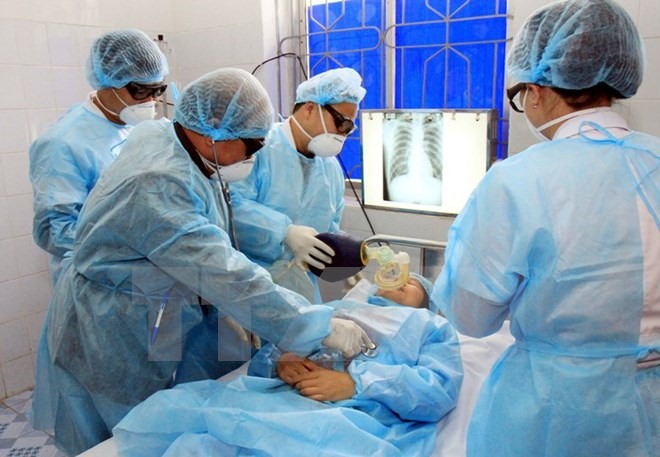 Society
Society

An online conference held by the Ministry of Health yesterday focused on urgent prevention measures against winter-spring diseases.
 |
| Health workers practise to provide emergency aid to a patient with influenza flu type A. — VNA/VNS Photo Thái Thuần |
HÀ NỘI — An online conference held by the Ministry of Health yesterday focused on urgent prevention measures against winter-spring diseases.
Chaired by Health Minister Nguyễn Thị Kim Tiến, the conference identified three main reasons for the rapid spread of infectious diseases in the winter-spring season: cold weather, increased transportation and trading of poultry, and the crowding of people during festivals.
Trần Đắc Phu, director of the Department of Preventive Medicine, said there was a high risk of dangerous and newly-emerging infectious diseases such as influenza A/H7N9, Mers-CoV and yellow fever infiltrating Việt Nam.
“There is a high risk of entry into our country and an outbreak occurring if we don’t take drastic preventive measures,” he said.
There is also a risk of other contagious diseases like avian flu, whooping-cough, diphtheria, measles, rubella, meningococcal meningitis and diarrhea, Phu said, noting that dengue fever had become a more complex risk last year.
Minister Tiến expressed her appreciation of efforts made thus far by localities to prevent epidemics from breaking out, including preventive measures against dengue fever.
She requested all health departments to strengthen early detection of winter-spring infectious diseases, provide timely treatment to reduce morbidity and mortality, and work to prevent hospital infections and cross-contamination.
She said community awareness of winter-spring diseases and risks should be strengthened so that people actively protect themselves and their families.
Việt Nam Medical Service Administration director Lương Ngọc Khuê said that in order to prevent winter-spring disease transmission in healthcare facilities, it was organising a health experts’ meeting to update guidelines for diagnosis and treatment of dengue fever and whooping cough.
The administration has asked health facilities to improve training for health workers and the latter to follow strict precautions for prevention and airborne transmission when dealing with patients and guiding their families.
2017 statistics
According to the Department of Preventive Medicine’s report, in 2017, measles cases were seen more in the north, and some provinces in the south. However, the number of measles cases decreased by 29.2 per cent against 2016.
In 2017, dengue fever was recorded in all 63 provinces and cities, with a total of 183,287 cases and 30 deaths. The number of dengue fever cases increased from the beginning of May to the end of August 2017. From early September 2017 until now, the number of cases has reduced rapidly in almost all localities.
A slight year-on-year decline was seen in the incidence of hand, foot and mouth disease, with 105,953 cases recorded, down 0.9 per cent against 2016. There were 48,404 hospitalisations and one death. — VNS




